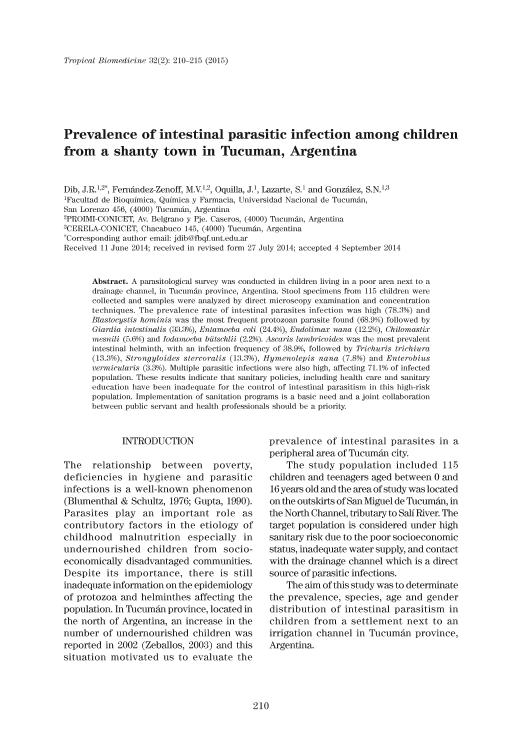Artículo
Prevalence of intestinal parasitic infection among children from a shanty town in Tucuman, Argentina
Dib, Julian Rafael ; Fernandez Zenoff, Maria Veronica
; Fernandez Zenoff, Maria Veronica ; Oquilla, Juana del Valle; Lazarte, S.; Gonzalez, Silvia Nelina
; Oquilla, Juana del Valle; Lazarte, S.; Gonzalez, Silvia Nelina
 ; Fernandez Zenoff, Maria Veronica
; Fernandez Zenoff, Maria Veronica ; Oquilla, Juana del Valle; Lazarte, S.; Gonzalez, Silvia Nelina
; Oquilla, Juana del Valle; Lazarte, S.; Gonzalez, Silvia Nelina
Fecha de publicación:
09/2015
Editorial:
Malaysian Soc Parasitology Tropical Medicine
Revista:
Tropical Biomedicine
ISSN:
0127-5720
Idioma:
Inglés
Tipo de recurso:
Artículo publicado
Clasificación temática:
Resumen
A parasitological survey was conducted in children living in a poor area next to a drainage channel, in Tucumán province, Argentina. Stool specimens from 115 children were collected and samples were analyzed by direct microscopy examination and concentration techniques. The prevalence rate of intestinal parasites infection was high (78.3%) and Blastocystis hominis was the most frequent protozoan parasite found (68.9%) followed by Giardia intestinalis (33.3%), Entamoeba coli (24.4%), Endolimax nana (12.2%), Chilomastix mesnili (5.6%) and Iodamoeba bütschlii (2.2%). Ascaris lumbricoides was the most prevalent intestinal helminth, with an infection frequency of 38.9%, followed by Trichuris trichiura (13.3%), Strongyloides stercoralis (13.3%), Hymenolepis nana (7.8%) and Enterobius vermicularis (3.3%). Multiple parasitic infections were also high, affecting 71.1% of infected population. These results indicate that sanitary policies, including health care and sanitary education have been inadequate for the control of intestinal parasitism in this high-risk population. Implementation of sanitation programs is a basic need and a joint collaboration between public servant and health professionals should be a priority.
Palabras clave:
INTESTINAL PARASITES
,
ARGENTINA
,
SHANTY TOWN
,
CHILDREN
Archivos asociados
Licencia
Identificadores
Colecciones
Articulos(CERELA)
Articulos de CENTRO DE REFERENCIA PARA LACTOBACILOS (I)
Articulos de CENTRO DE REFERENCIA PARA LACTOBACILOS (I)
Articulos(PROIMI)
Articulos de PLANTA PILOTO DE PROC.IND.MICROBIOLOGICOS (I)
Articulos de PLANTA PILOTO DE PROC.IND.MICROBIOLOGICOS (I)
Citación
Dib, Julian Rafael; Fernandez Zenoff, Maria Veronica; Oquilla, Juana del Valle; Lazarte, S.; Gonzalez, Silvia Nelina; Prevalence of intestinal parasitic infection among children from a shanty town in Tucuman, Argentina; Malaysian Soc Parasitology Tropical Medicine; Tropical Biomedicine; 32; 2; 9-2015; 210-215
Compartir



